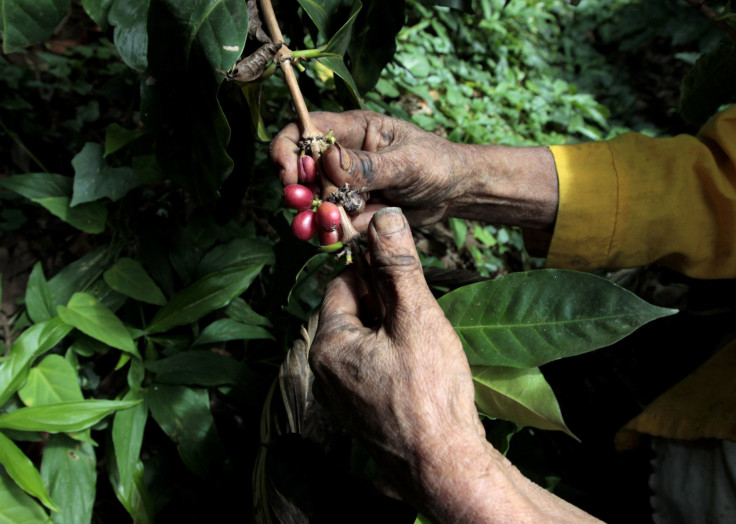Coffee Rust Has Claimed $1B In Losses And 250,000 Jobs In Central America, US Fears Increase Of Migration
How Coffee Rust Is Hurting Central America's Economy

MEXICO CITY -- It starts with a tiny yellow spot, but it quickly turns a field of coffee crops into a mess of dead leaves. Known as "coffee rust," the plague that has slashed production in Central America to its lowest level in half a decade, will not only jolt the price of a cup of coffee but is also likely to devastate the workforce of the region and increase migration of undocumented workers into the U.S.
Since 2012, when the fungus called roya in Spanish was first observed, it has spread to half of the coffee plantations from Guatemala to Panama. Total production has dropped 20 percent since 2011, and losses total more than $1 billion. The plague is threatening more than 500,000 jobs in a region where coffee represents 13.5 percent of exports and provides a livelihood, directly and indirectly, to 5 million people -- 10 percent of the region's population.
The U.S. government has provided $14 million in aid to help combat the fungus, partnering with Texas researchers to find a solution.
“If the problem persists, employment and stability in the region could be compromised,” Mark Feierstein, administrator of the United States Agency for International Development (USAID), which is distributing the aid, said. “It could affect migration patterns and prompt an increase of immigration to the U.S.”
Between 2011 and 2013, an estimated 255,000 people have lost their jobs. USAID predicts that coffee production could fall between 15 and 40 percent in the next two years.
The rust has ruined crops from Mexico to Peru, but it has hit the hardest in the following Central American countries.
El Salvador
In normal years, the coffee industry employs 93,000 Salvadorans, and yields around 1.4 million bags annually (2011), according to numbers from the Salvadoran Central Bank. Coffee represents 2 percent of the country’s gross domestic product (GDP).
How has production been affected: Production fell 378,000 bags between 2011 and 2013, reducing the annual amount to 1.2 million
How many jobs have been cut: 45,000
Total losses: $61 million -- 20 percent drop in revenue from exports -- from 2011 to 2013
Honduras
In normal years, the coffee industry employs 100,000 Hondurans, and yields around 6 million bags annually (2011), according to numbers from the United Nations World Food Program. Coffee represents 7.3 percent of the country’s GDP.
How has production been affected: Production fell 1.3 million bags between 2011 and 2013, reducing annual production to 4.7 million
How many jobs have been cut: 50,000
Total losses: $656 million -- 45 percent drop in revenue from exports -- from 2012 to 2014
Guatemala
In normal years, the coffee industry employs 500,000 Guatemalans, and yields around 3.4 million bags annually (2011), according to numbers from the Guatemalan Ministry of Agriculture. Coffee represents 2.5 percent of the country’s GDP.
How has production been affected: Production fell 583,000 bags between 2011 and 2013, reducing annual production to 2.8 million bags
How many jobs have been cut: 71,000
Total losses: $547.4 million -- 42 percent drop in revenue from exports -- from 2011 to 2013
Nicaragua
In normal years, the coffee industry employs 350,000 Nicaraguans, and yields around 1.5 million bags annually (2011), according to numbers from the Nicaraguan Central Bank. Coffee represents 6.1 percent of the country’s GDP.
How has production been affected: Production fell 475,000 bags between 2011 and 2013, reducing annual production to 1 million
How many jobs have been cut: 64,000
Total losses: $172.3 million -- 33 percent drop in revenue from exports -- from 2011 to 2013
Costa Rica
In normal years, the coffee industry employs 55,000 Costa Ricans, and yields around 105,000 bags (2011), according to numbers from the Costa Rican Ministry of Agriculture. Coffee represents 1 percent of the country’s GDP.
How has production been affected: Production fell 71,000 bags between 2011 and 2013, reducing annual production to 34,000 bags
How many jobs have been cut: 25,000
Total losses: $110.5 million -- 28 percent drop in revenue from exports -- from 2011 to 2013
© Copyright IBTimes 2024. All rights reserved.











